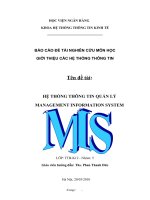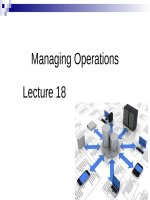Lecture Business management information system - Lecture 29: Supporting collaboration
Bạn đang xem bản rút gọn của tài liệu. Xem và tải ngay bản đầy đủ của tài liệu tại đây (1.65 MB, 52 trang )
Supporting
Collaboration
Lecture
29
Today’s Lecture
n
Introduction
¨ Teams: The Basis of Organizations
n
Understanding Groups
¨ Characteristics of Groups
¨ Types of Groups
¨ Communities of Practice
¨ Network Armies
Today’s Lecture cont.
n
Systems to Support Collaboration
¨ Supporting Same Time/Same Place Collaboration
¨ Supporting Same Time/Same Place Presentations
and Discussions
¨ Supporting Different Place Collaboration
n
Managing Collaboration in Virtual Organizations
¨ Motivating a Virtual Workforce
¨ Governing Virtual Organizations
Introduction
n
The company of the future could be a collection of
online communities:
¨ Some are internal and others reach outside the
organization’s boundaries into one’s business
ecosystem
¨ Some are designed and formed outright and
others just grow on their own
n
A main job of executives and managers is to foster
these communities and the collaboration they
engender
A major job of CIOs is to provide the technology to
support online communities and online collaboration
n
Organizations
are becoming information-based,
and
Introduction
Cont…
will thus be organized not like a manufacturing
organization but more like a hospital, which is team
based
Teams: the Basis of Organizations
Hospitals:
¨ Have specialty units, each with its own knowledge,
training, and language
¨ Work in the units is done by ad hoc teams,
assembled to address a patient’s condition and
diagnosis
Introduction Cont…
n
Systems that contain support groups are important
because most people spend 60 to 80 percent of their
time working with others
¨ Yet, people seem to feel they are most productive
when they work alone
Introduction Cont..
•
We are in the third evolution in the structure of
Teams: the Basis of Organizations cont.
management:
1. Around 1900 – separated business ownership
form management.
2.
1920s – created the ‘command and control’
corporation.
3.
Now – organization of knowledge specialists
Introduction Cont..
n
Organizations are becoming flatter, with fewer ‘HQ’ staff
and many specialists out in operating units
n
Groupware – electronic tools that support teams of
collaborators – represents a fundamental change in the
way people think about using computers
Understanding Groups
n
n
Collaboration is all about getting work done in a
group rather than individually
Characteristics of Groups
Not all groups are the same. Some characteristics
that differentiate groups include:
¨ Membership – Some groups are open, some are
closed.
¨ Interaction – Some groups are loosely coupled
(salespeople with their own territories), others
work closely together (project team)
Understanding Groups Cont..
¨
¨
¨
n
Hierarchy – Some groups have a chain of command
(tiers of committees)
Location – Some members are co-located, some are
dispersed
Time – Some groups are short-lived, some are
ongoing. Some work intensely at times, others do
not
These characteristics illustrate that providing computerbased support for groups is not uniform because of the
many variations
¨ Initially = intra-company groups
¨ Now = could be anything!
Understanding Groups
n
Types of
Groups
Authority groups: involve
formal
authority (and often
hierarchy), such as boss and subordinates; membership
closed; coupling tight
n
Intradepartmental groups: can have members all doing
essentially the same work, often under the same boss;
membership closed; interaction can range from tight to
loose coupling; hierarchy
n
Project teams: generally have members who work fulltime to accomplish a goal within a specific schedule;
membership closed; coupling tight; hierarchy
Understanding Groups
Types of Groups cont.
n
Interdepartmental work groups: pass work from
department to department (purchasing, receiving,
accounts payable) in a chain, forming a super group;
membership closed; coupling tight; no hierarchy
n
Committees and task forces: formed to deal with a
subject area or issue, then disband; does not require
full-time work by the members; membership not too
closed; interaction not as tightly coupled
n
Business relationship groups: relationships with
customers, groups of customers, suppliers, and so on;
membership open; interaction loosely coupled; no
hierarchy
Understanding Groups
Types of Groups cont.
n
Peer groups: meet to exchange ideas and opinions;
activities of each member are largely independent of
the activities of the other members
¨
Membership can range
¨
Interaction loosely coupled
¨
No hierarchy
Understanding Groups
Types of Groups cont.
n
n
Networks: groups of people who socialize, exchange
information, and expand the number of their personal
acquaintances
Electronic groups: include chat rooms, multi-user
domains, user groups, and virtual worlds, all forms of
groups that have formed on the Internet to socialize,
find information, entertain themselves, gain comfort, or
just experiment with the new online world
¨
Membership wide open
¨
No hierarchy
¨
Loosely coupled
Understanding Groups
n
n
Types of Groups cont.
“Communities of practice”: group of people who work
or play together for so long that they have developed
an identifiable way of doing things
¨ e.g. volunteer organization
Network Armies: Widely dispersed groups of people
form to further a cause
¨
Open source software
¨
Political parties???
Understanding Groups
n
CoPs are all about managing knowledge, capturing and
spreading Communities
know-how, ideas,
innovations,
and experience
of Practice
(CoPs)
n
In some enterprises, CoPs form the foundation of their
knowledge management efforts
n
CoPs resist being managed. But some enterprises have
seen their value and have learned how to nurture them
n
Understanding Groups
Communities of Practice (CoPs) cont.
Though informal, some CoPs have had a profound
effect on their enterprise
¨
Driving strategies
¨
Creating new lines of business
¨
Spreading best practices, and
¨
Solving seemingly intractable problems
DAIMLER CHRYSLER
Case Example – Community of Practice
n
To compete against the Japanese, Chrysler
management reorganized the company into “car
platforms,” such as Jeep, minivan, truck, and small
car
n
This change significantly reduced development time,
but employees with similar jobs needed to
communicate across the platforms, so some began
meeting informally
DAIMLER CHRYSLER
Case Example – Community of Practice cont..
n
Rather than formalize these cross-platform groups, they
became known as Tech Clubs (communities of practice)
supported and sanctioned by top management
n
They began to take responsibility for their area of
expertise by conducting design reviews, and even
revived the old idea of Engineering Books of Knowledge
n
Creating the books has led to debates and discussions;
thus, while they build practice standards, they also build
community
Understanding Groups
n
Communities of Practice (CoPs) cont.
Identifying Potential CoPs – Companies can use CoP
consultants to help employees interested in forming a
CoP
n
Providing a CoP Infrastructure – Executives need to
give CoPs legitimacy because they lack resources
and formal standing in the enterprise
n
Measuring CoPs – To measure CoPs appropriately
often means measuring their contributions
nontraditionally because their effects may only show
up in a team member’s department, not in the
community’s work
Understanding Groups
Network Armies
n
These sets of individuals and communities are aligned
by a cause
¨ So they are as permanent as their common agenda
n
Their cohesive force is their value system
n
Their communications are open, taking place in forums
that anyone can join
Understanding Groups
Network Armies cont.
n
Network armies have existed for a long time, but they
can now suddenly appear with a lot of power because of
three developments:
1.
High-speed information flows due to a common
language (English) and communication system
(Internet)
2.
The geometrically expanding power of networks
(adding one person geometrically increases the
number of interconnections), and
3.
The international visibility now afforded just about any
cause
Understanding Groups
Network Armies cont.
n
Hierarchies have a tremendously difficult time fighting
network armies because there is no single leader, simply
a “hydra with many heads.”
THE OPEN SOURCE MOVEMENT
Case Example – Network Army
n
In the open source movement, members are volunteers
and none is paid
n
They code for the fun of it because they like to
fraternize with like-minded developers and be part of a
worthy cause, such as “writing software that doesn’t
suck.”
THE OPEN SOURCE MOVEMENT
Case Example – Network Army Cont..
n
The movement has a massive flat structure with:
¨ Four
¨ Six
“influencers,”
to eight distributors
¨ 200
project leaders, and
¨ 750,000
volunteer developers









